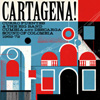 The late Curro Fuentes was quite a fascinating guy.  The youngest brother of the Fuentes musical dynasty that dominated Colombian music for four decades, he stayed behind on the coast and started his own studio when Discos Fuentes relocated to the city of Medellin (he found highland food to be "insipid"anyway).  Combining some of Colombia's biggest jazzmen with the most exciting young musicians culled from Cartegena's many red-light district casinos, brothels, and strip clubs, he produced a slew of scorching, sexed-up big band records in the '60s.  Cartagena! assembles many of them, but the high level of quality here makes me think that the vault is far from empty.  I sincerely hope there will be a sequel.
The late Curro Fuentes was quite a fascinating guy.  The youngest brother of the Fuentes musical dynasty that dominated Colombian music for four decades, he stayed behind on the coast and started his own studio when Discos Fuentes relocated to the city of Medellin (he found highland food to be "insipid"anyway).  Combining some of Colombia's biggest jazzmen with the most exciting young musicians culled from Cartegena's many red-light district casinos, brothels, and strip clubs, he produced a slew of scorching, sexed-up big band records in the '60s.  Cartagena! assembles many of them, but the high level of quality here makes me think that the vault is far from empty.  I sincerely hope there will be a sequel.
Cartagena! is a sequel of sorts to 2007's Columbia!, which covered the output of Discos Fuentes (the label run by Curro's brothers Antonio and Rafael) around roughly the same period.  Despite Discos Fuentes' huge success, Curro always chose to remain separate, starting off with with his own Discos Curros imprint before eventually teaming up with Phillips.  In a way, Curro's studio was kind of a Colombian analog to Factory Records, as it was very devoted to Cartagena's local music scene and there was a lot of overlap between bands–many musicians that led their own bands happily lended their talents to other ensembles.  Consequently, Curro's productions drew from a pretty unparalleled talent pool.  Equally important is the fact that Fuentes had very strong opinions about what sounded good and wasn't at all shy about sharing them, replacing percussionists and pianists himself if they couldn't get a track just right.  Also, he was one of the first cumbia producers to make heavy use of electric bass, which he liked quite loud.
The eclectic array of performers that Fuentes drew together resulted in some interesting cross-pollinations between Latin music genres, which goes a long way towards explaining why this music is so spectacular.  The young musicians from Cartagena's clubs made damn sure that the rhythms were raucous and propulsive, while their more established counterparts ensured that the arrangements were skillful and inventive.  Despite the disparate backgrounds and the high level of musicianship, everyone could agree upon the very populist objective of heating up dancefloors.  As such, this music was very focused on appealingly accessible elements like wild percussion, sultry grooves, and memorable hooks, which is quite different than where American jazz was headed around the same time.
Of all the artists, I was most impressed by saxophonist/bandleader Lucho Bermudez, who is the sole returnee from Colombia! (Soundway sure loves exclamation points).  Bermudez's two pieces are the most perfect synthesis of all of the great stuff happening on this album: fluid solos, driving (but not hyperactive) grooves, virtuosic percussion, infectious enthusiasm, quirkiness, character, and lots of vocal whoops and yelps (which are very important to me).  He is not the sole stand-out by any means, though, as I was similarly taken with the songs by several other bands–particularly that of Lucho's chief rival, Alex Acosta.
Primary compiler Roberto Guymant contributes some alternately informative and amusingly hyperbole-filled liner notes, the latter of which I found extremely charming ("The first time I heard this track, my brain immediately melted out my ears and dribbled down my shirt.").  Even though I don't quite agree that Crescensio Camacho's trumpets are apocalyptic or that Los Seven Del Swing embody what Black Sabbath would have sounded like if they'd been raised on the Colombia coast, his enthusiasm is pretty contagious.  Also, he clearly knows what he is talking about both musically and historically, which is not easy when there are so many regional scenes and similar-sounding genres (to my non-Colombian ears) combining and mutating.  To give an example, I learned that the upper classes were scandalized when jazz and cumbia were first combined in the 1940s because it made young Colombians "dance like blacks."  Fortunately, the young people had a lot more influence on where their culture was headed than the wealthy, reactionary types.  Of course, as much as I love colorful anecdotes and uncomfortable cultural factoids, the most important thing of all is quality of the music and Roberto and his co-curators simply have great taste.  A few pieces are certainly too frenzied or locked-groove-sounding for my taste, but they are largely outnumbered by excellent ones.  This is a thoroughly fun and vibrant album.
Samples:
- Lucho Bermudez Y Su Orquesta Sabanera, "Arroz Con Coco"
- Orlando Fortich Y Su Orquesta, "Yolanda"
- Alex Acosta Y Su Orquesta, "La Gozadera"
 
Read More


